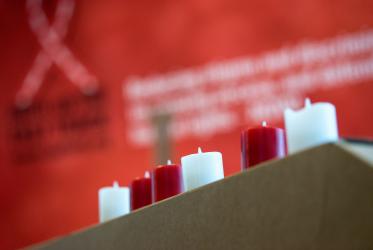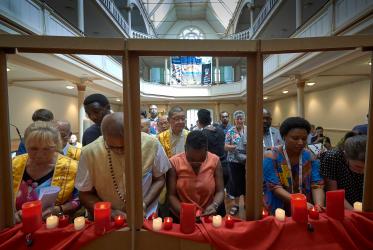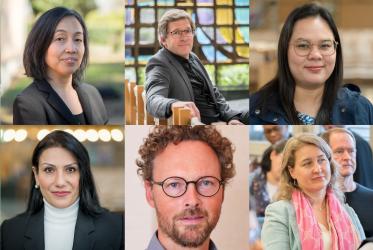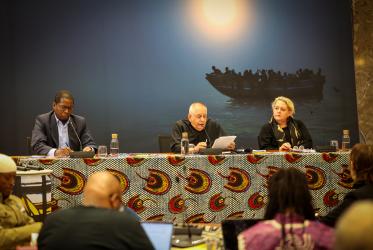On World AIDS Day 2017, the World Council of Churches – Ecumenical Advocacy Alliance (WCC-EAA) brought together representatives of faith-based organizations as well as public sector and inter-governmental organizations at the Ecumenical Centre in Geneva on 1 December.
The event saw a commemorative prayer service, an interactive art exhibition, and a round table discussion on how to improve access to testing and treatment for children and adolescents living with HIV, particularly by means of education.
“The World Council of Churches engages in issues of HIV and AIDS through two ecumenical initiatives,” explained WCC deputy general secretary Dr Isabel Apawo Phiri. “But for many of us, we do not just engage in these issues because it is our job, but because of who we are, and where we come from. The challenges of HIV and AIDS are issues that touch and affect us personally.”
World AIDS Day 2017 also marked a symbolic end to the WCC’s campaign “Leading by Example: Religious Leaders and HIV Testing”, through which more than 1,000 religious leaders around the world have spoken up publicly to encourage HIV testing.
“While we will continue to mobilize religious leaders in promoting HIV testing, in the next few years we will be fast-tracking our efforts towards the rights and lives of children and adolescents living with HIV,” said Francesca Merico, coordinator of the WCC-EAA HIV Campaign.
“What may sometimes sound quite technical is actually very simple,” Merico added. “There is a lack of access to testing for children. And what is more, there is a lack of appropriate, child-friendly medicines to treat HIV. This is why we have to mobilize all sectors to get children and adolescents to know their status, access medication, and stay on treatment. Because if you are HIV positive and you do not have access to testing and treatment, you will not survive.”
Mobilizing across sectors
Monsignor Robert J. Vitillo, general secretary of the International Catholic Migration Commission, spoke on the role of faith-based organizations in responding to the HIV epidemic. ”FBOs have been part of responding to HIV from the very beginning. Before government authorities could sit down to make action plans, before the international community could coordinate a response, faith communities gave care, love and protection to those in need,” Vitillo reflected.
”Looking at where we are today, we can see that we have come a long way,” continued Greg Perry, executive director of the Medicines Patent Pool, who addressed the processes involved in developing HIV treatment formulas for children.
“But still, there are so many pitfalls to start going backwards,” Perry added. ”Across the board, putting it simply, we see that the adult formulas are there, and the paediatric formulas are not. But there are new treatment regimes in the pipeline, and together we have to make sure that as soon as these are ready for distribution, all countries are prepared to make them available immediately.”
Strengthening the voices of children and adolescents
Gelise McCullough from Painting for an Education brought to the event an interactive exhibition, Kisumu - Nairobi - Geneva - art from them to us, featuring paintings and artwork from HIV positive children and adolescents in Kenya.
”Through works of art, we are able to strengthen the confidence of young people living with HIV, and encourage them to find ways to share their stories,” McCullough explained.
“Children and adolescents face a lot of stigma relating to HIV, and we need to hear their stories, and help them get access to education, with all that this means by way of affording the books, uniforms, meals, etc. But ultimately, education is not only vital in itself, but can help young people living with HIV make healthier life choices, for example by adhering to treatment, and it can also offer opportunities to improve their livelihoods, and strengthen their health-seeking behaviour.”
“But if we all do a little, together we can achieve a lot,” McCullough concluded.
High-resolution photos, free to download
World AIDS Day 2017 - prayer service, exhibition, panel discussion








